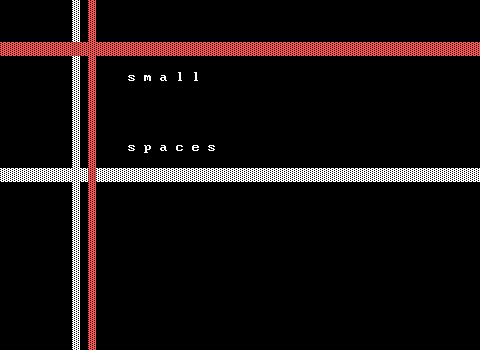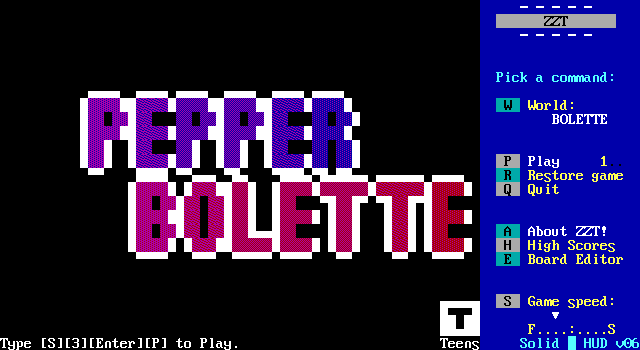
Our poll winner for May was Zephyre's Pepper Bolette Special Edition, a game that has been on my list of games I've been wanting to get around to, so I was pleased to see it take the lead.
Pepper Bolette (as I will refer to it rather than append SE every time), is a very high quality world that demonstrates a level of creativity and polish that easily make it one of ZZT"s most ambitious action/adventure games. This is quite a feat when you consider that more than one-third of ZZT worlds on the Museum have "adventure" show up under the genre field. The game features an inventory system more like you'd expect from a Legend of Zelda game than something made in ZZT. The graphics are distinct, with great use of color to differentiate what could easily have been very samey locations, and gorgeous animations that turn normally static background areas into lavishly detailed environments. Seriously, the number of times I stopped to capture some GIFs of animated effects that grabbed my attention was immense enough to the point where I can't even include all of them.
In addition to being a treat for the eyes, the game also provides a significant challenge. The enemies are very agile, while the player character is considerably weak and limited in resources. Zephyre requests on the title screen that the game be played on speed three rather than five, a decision which inherently makes fighting demanding while also helping to relieve tedium from wandering/backtracking throughout the world. This is very much intentional. Even then, Zephyre very much wants you to challenge yourself with this one, with the games text file stating that you are supposed to challenge yourself to beat the game without making any saves.
I vetoed this extra effort, and genuinely can't imagine anybody getting through Pepper Bolette this way. This is a game with a deliberately higher than average difficulty, which may end up ultimately being its fatal flaw today. The good news is of course, nothing stops you from saving, cheating, or slowing the game back down to ZZT's default speed. If you enjoy a good challenge, consider Pepper Bolette a must-play. If not, the visuals alone make it worthwhile to check out, even if you have to tap out at some point or just start cheating for resources to brute-force your way through to the end.
Taste Peppery
At its core, Pepper Bolette is a rather unique blend of traditional goals with then modern (this is from 2004 after all) storytelling and world building. Commodore's review describes it quite well in the article's blurb:
“Eat a mushroom? Bug out? Collect some purple keys? It must be a ZZT game!”
— Commodore
The game opens as many popular titles of the late 90s and early 2000s might: You (nameless) awaken after eating a strange mushroom, finding yourself in a surreal world full of unusual characters, with little idea of what's going on, why you're here, and how to get home.
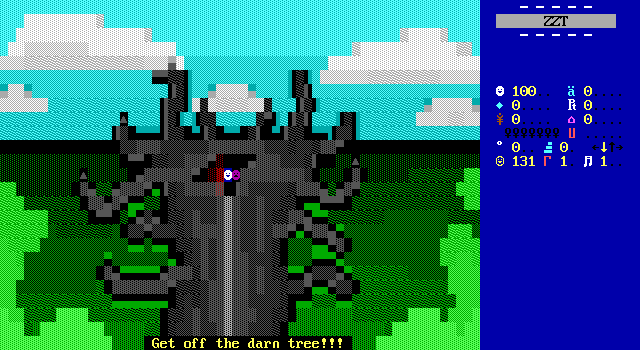
It's a pinch of Pop!, a touch Edible Vomit, with a dash of Second Earth. Though despite the surface level comparisons to trippy-ZZT games on the past, Pepper Bolette isn't about the power of a wandering mind or a psychedelic experience gone wrong. Your experiment with mushrooms comes from some doctors without scruples, who were looking for volunteers to find out its effects. The price tag for going along with it is enough to buy that new game console you've been wanting, and so you try your luck only to black out almost immediately, awakening on top of a gigantic dead tree in the world of Bolette.
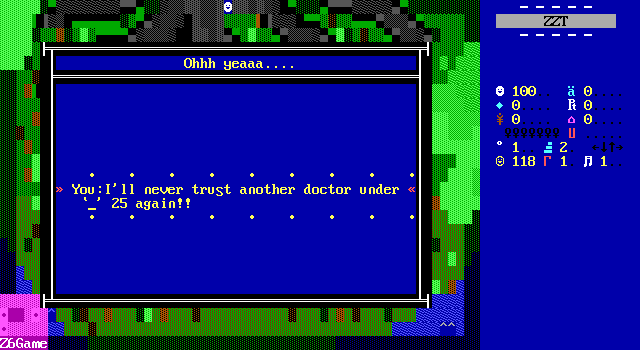
Pepper Bolette is not the trippy game one might assume from its initial setup. The design is far closer to something like Link's Awakening than anything in ZZT. The nature of the world of Bolette and what it means to be there is questioned throughout the game with many of its occupants believing themselves to already be dead, and stuck in a world between heaven and hell.
Your job, is to wake up, whatever that might mean.
What it means in terms of the game's ending is something I'd prefer not to spoil. What it means in terms of gameplay is far more simple. Explore the world of Bolette, find the four purple spheres unlock the "Door Spheres" that block a mysterious gate to somewhere else, and generally help people out along the way. Yes, Pepper Bolette is literally a purple key collecting game, part of a long lineage of ZZT games that goes all the way back to Town itself. The "spheres" are regular purple keys, and the doors are just regular doors with STK colors to make them appear as nothing more than un-filled dark purple circles.
ZEPHFONT

It wouldn't be possible to discuss the game's visuals without discussing its decision to use a custom font. This is the most straightforward way to make any ZZT game look different from the rest, but by no means is it the font alone that makes Pepper Bolette look as good as it does.
One criticism here are the changes to the alphabet. The letters are stretched out a little bit with mostly minor changes, but the lowercase letters that are already naturally taller to begin with end up having to be shifted to fit a further stretched variation. In practice, this makes the lengthy amount of text contained in the game surprisingly rough on the eyes.
Still, the font provides enough radical changes to characters for the purposes of this game that playing it without the font will ruin the appearance of quite a lot of scenery. Notable additions include some triangle shapes, some more rounded smiley faces, bricks, chairs, and some extra alternate patterns used for shading. The most significant of which is the character for water being significantly more filled in than usual.
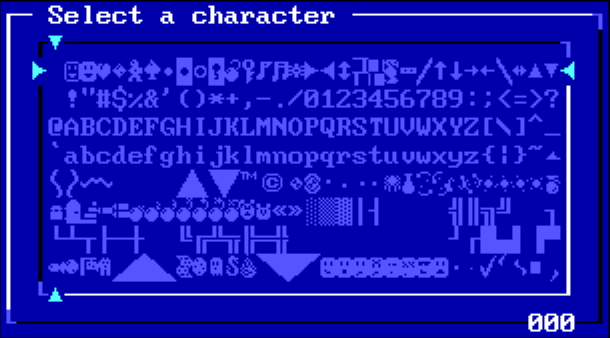
There's somewhat of a MegaZeux feeling with some of the character choices, but overall its changes are surprisingly small with many infrequently used characters in English ZZT worlds like accented letters remaining pristine.
The font also changes the passage character into stairs, which ends up seeming like an odd choice. I discussed the issue with custom fonts in ZZT and how it leads to a loss of versatility for characters in a now ancient article which still sums up my troubles with alternate passage characters today.
“If you're not using a custom font, then your passage is going to be a logical equivalence character for a cave, door, or staircase. The passage character becomes abstract enough that it doesn't take too much of a leap to see it as a door or stairs, and though it might be more lacking as a cave, the limitations of ZZT are expected. Creating a font often means "fixing" the appearance of some tiles, but that comes at the expense of removing their versatility as abstract forms.”
— Dr. Dos
You do you of course, but I did notice that only once in the game does a passage actually take you up or down stairs, other than perhaps a generous reading of descending down into a cave system. The character feels particularly unusual in the mostly wooded areas seen throughout the game.
Stairs aside though, overall the font really helps the game create its atmosphere. I was especially surprised at how effective the replaced water character was. The extra opaqueness is used to great effect and never feels like it's making the classic solid to normal to breakable to water blending technique look off.
The Backpack System
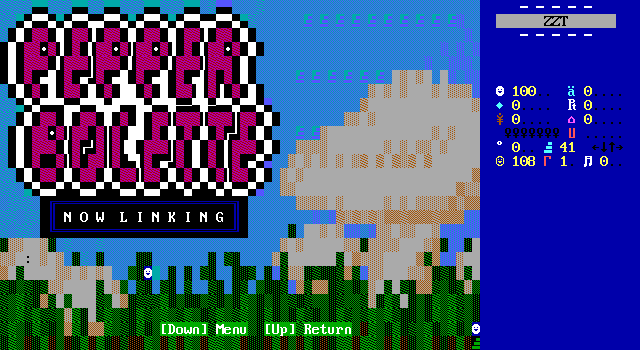
Pepper Bolette always feels like it's trying to bill itself as something more than a typical ZZT game. The font is one component of this, but the backpack is the most distinct feature. By typing ?-M the player can set in motion some objects that will result in the eventual warp to "the linking board". This board has a dedicated passage to every board in the game. From here the player can use a player clone to move south and transport themselves into the backpack screen, or hit up to activate another object performing the warp in reverse, returning them to where they started.
This is something that was, to my knowledge, brand new. Using player clones, duplicators, and passages to change boards was an old trick well before Pepper Bolette, but the technique tends to be used for one-way transports. In order to have the space both physically on the board as well as in terms of memory usage, this intermission board needs to exist.
I suspect this influenced the increase game speed requirement, as this system is at the mercy of duplicator cycles so the duration of time between the duplicator and passage being ready can vary by a noticeable amount. Adjusting the game speed helps quite a bit to make this system go from being something to put up with, to something quick enough that it's rarely bothersome to access the inventory for most of the game.
Even with the very ZZT solution of using two boards to handle the backpack, the system feels once again very Zelda. Given how much of an influence console games had on ZZTers, this is the kind of thing I'm sure I'm not alone in having dreamed of. Having this backpack board does a lot to make the game feel rather advanced and impressive.
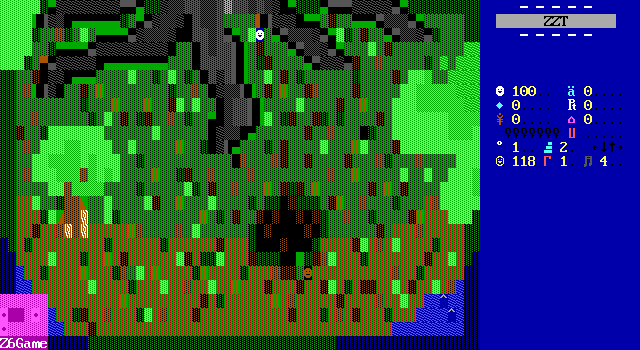
As is often the case with limit-pushing ZZT-OOP, having a dedicated inventory board compared to the more expected technique of having a menu written from within ZZT-OOP (as in countless inventory-based adventure games) comes at a hefty cost.
Nearly every board in the game supports opening your backpack on it. In order to support this, every board therefore has this little purple box tucked in a corner. Little effort is made to try and blend it into each board (probably because of the tedium involved), and in fact, the engine even proudly labels itself "Z6Game" after "Zephyre Syx", the full author name the world is credited to. Having to dedicate this much space on every board isn't too much of a problem, but this is a fairly open exploratory game. Exits are far more often found by walking to the edge of a board rather than going in a passage so there are definitely boards where its presence kind of gets in the way. In the worst instances, an otherwise open connection from one board to the next will be blocked in certain spaces because of this engine.
Ultimately, the presence of a bright purple box isn't that big of a deal. ZZT boards are a lot larger than you think with lots of dead space where the engine isn't going to really get in the way. There is one much more significant annoyance with the system: Since it relies on duplicators, this means that every single board will constantly be playing the blocked duplicator sound effect.
Commodore's review mentioned opting to play the game without sound, which is indeed sound advice. The sound is something that experienced ZZTers are probably pretty good at tuning out to some degree, but here it's a true test of your endurance. Many games that otherwise hide that a board warp is going to occur will betray their secret early due to the noise. Objects can be used to play silence and essentially stop the noise, but then there are no sounds at all. It's a solution that's okay for a single board to suddenly go silent, but I can't stress enough how actually important hearing the player and objects shooting bullets is to making a ZZT game feel "right". Throughout my playthrough of the game, I was constantly toggling sound to give my ears a rest before wanting to turn it back on for busier action boards so they'd feel nicer.
Today thanks to having source code available, making adjustments to silence duplicators and nothing else is an option, and in fact one that I may toss together just to accompany this Closer Look, as the duplicator noise is by far the worst thing about this game by a significant margin. Strangely, Zephyre doesn't suggest playing with the sound off, and in many cases puts in some original sound effects which I fear have been destined to fall on deaf ears.

Cacophony aside, the actual backpack interface is an excellent example of how ZZT is both surprisingly capable of replicating the norms of 2D console games while also rarely being so good that it's worth the effort. Don't get me wrong, I like the backpack system Zephyre has made here. This is undeniably something that many ZZTers wanted to include in their games, with Zephyre being the one to actually pull it off. Actually using it for awhile, and you'll correctly realize that this system is impressive, but slow and clunky.
The controls are a bit of a pain due to the limited inputs provided by ZZT. This kind of menu certainly wouldn't look out of place in a console game, but if one had the controls that are used here, there would be numerous complaints. For Zephyre such complaints aren't fair. This is ZZT and your only real options are the arrows keys.
First, since the player is taken to this board via passage, the game is paused automatically. Moving down is dedicated to unpause the game without adjusting any settings. Moving left is also reserved. When this key is pressed, another player clone will return the player to the linking board in preparation for returning to gameplay. That brings us down to just two inputs for actually working with the menu on display here.
Up will toggle between two different ranged weapons.
Right meanwhile gets a bit too much to chew and is responsible for selecting which of nine items the player will actively be using. That's quite a lot of button presses to navigate from the first item to the last, and since the navigation is only in one direction, even if two items are close to each other in the list, it will be significantly faster to go from the first to the second rather than the second to the first. Code checks also need to be made when cycling through the list as well which results in a sluggish response time that can lead to a lot of aggravation of you accidentally overshoot an item.
Plus, the list also has you cycle through items the player doesn't have, so early on when you have just two items, to swap between them can still take a considerable amount of time.
The wasted time compounds when you realize every item is an active use item. The translator is necessary to speak with mushroom-folk. In any other ZZT game, the object would just check if you have the translator or not and act accordingly. Here the player will have to regularly go into the menu to pull out the translator, only to then put it away so they can get back to doing what they were doing before. The engine here has to justify itself by requiring its regular usage, but most of the items are simple enough that while the game wouldn't be as impressive with this system removed, it would be more streamlined.
Equipment Catalog
- Brackish 1cm - The first weapon the player will find. Prior to this all combat is melee only so you better find it as soon as possible.
- Rifle Cannon - A stronger weapon capable of dealing with some otherwise unkillable foes that also has greater knock-back for some enemies as well. I didn't acquire this until the very end of the game so I can't speak for how much of a difference it really makes.
- Bombs - It wouldn't be
ZeldaZZT if there weren't bombs. These aren't general purpose items, but rather can only be used at specific points. - Armour - A store sells two levels of armor, both of which cost more gems than I ever had at any point in the game, which seems to be for the best as the flag isn't used anywhere making it pointless.
- Translator - Used to talk with mushroom folk and acquire critical information throughout the game.
- Compass - Reveals hidden paths in fog.
- Truth Specs - Reveals hidden items.
- Water Disk - Allows you to walk on water.
- Grapple Hook - Allows you to scale some otherwise un-climbable walls.
- Rock Ice - Allows you to survive immense heat.
- Heat Specs - Reveals hidden enemies.
- Silencer - Unused. Seems to only be acquirable in a bonus "Hyper" mode unlocked after beating the game.
- Power Arm - Allows you to lift heavy things.
Going to my complaint with items needed to be actively selected rather than passively applied, you can see that most of them don't provide much of a meaningful choice in the way that a Zelda, Mega Man, or Metroidvania of your choosing provide good reasons to change items regularly. There's very little gained by not letting the player have the translator out at all times, or allowing the use of the water disk and say truth specs simultaneously.
The only time I felt like the system's one-item-at-a-time rule was relevant was with the rock ice. It's still silly to have to put it away, but it did feel like a meaningful choice as to whether or not it was worth switching to the grapple hook and suffering heat damage in order to be able to reach some areas with items that required it.
Lastly, there's also a "Music" option which always says NO. A flag can be manually set to change it to YES, and several objects have checks for the flag to determine if music should be played or not. This means there's a lot of seemingly unused music as well. Pepper Bolette is a very curious game in terms of how "finished" it truly is.
Zephyre's inventory system isn't without problems. It's slow, it hinders the gameplay more than it helps, it's awkward to use, and yet I still feel glad it was there. The system isn't as good as what could more easily have been done in ZZT, but its intricacies really make Pepper Bolette feel like its own game, with little thought as to what "ZZT games" do. At the very least, I'm glad to see somebody actually did implement such a system. To do so in a way that didn't break once in all the time I spent with the game is genuinely impressive. There's a lot of issues that can crop up with player clones, and these kind of duplicator powered passage warps, which Zephyre avoids entirely. The backpack system was an experiment whose results probably aren't quite what Zephyre had hoped for, but to be able to see what such a system actually plays like is a great way of proving the hypothetical possible. I can't fault Zephyre's experiment for not being a complete success, when the only way to know for sure was to try.
It should go without saying then that a ZZT source port like Weave, can probably do the system justice. There the board warps can be safe, silent, and instantaneous. The menus can do a lot more with keyboard reading, and even sticking to basic ZZT-OOP it would at least free up some arrow keys to speed up navigation. Aside from the translator, most items have clearly defined uses in very limited areas. Inventory juggling is pretty uncommon save for that translator, and even just making that item the sole-passive upgrade would go a long way to making this a more viable system.
The World of Bolette
Once you understand how the backpack works, you're able to start enjoying the actual game. Exploration is centered around a small village and its (mostly) safe surrounding areas. From here the player can immediately begin spelunking several caves which may lead to important items, new locations, or just some useful supplies.
Practice Cave
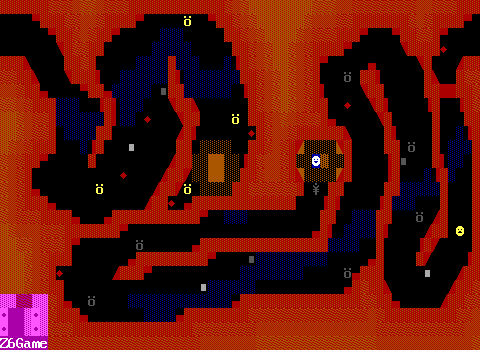

After a brief opening explaining the Pepper Bolette mushroom the player is thrust into a little tutorial cave where you'll inevitably learn about the difficulty of melee combat.
This starting cave is just this single board. It is dark and loops in on itself, which does a clever job of masking its small size.
This board is essential to see with the lights on, as the font is used to great effect here to really make the cave feel less rigid thanks to the use of triangular characters in the font. Despite the many caves in Pepper Bolette, the extra detailing is only seen here, which is a bit of a shame as the design here really makes the game stand out among the countless caves of countless dungeon crawlers made with ZZT.
Yllimpse Village
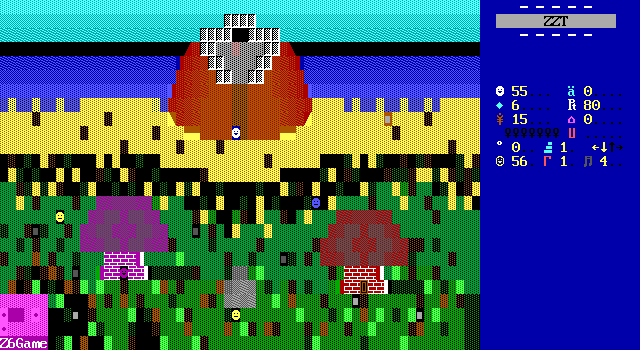
The cave is exited via a mysterious force that launches you straight up into the sky and has you land on a small hill next to the game's first village. Here the brickwork mushrooms and animated waves on the coast both make things come off differently from your average ZZT game. The town is really just this one board, but the surrounding boards offer more people to talk to, and get some ideas of where you might want to go in the near future.
The notable feature here is the purple mushroom building which houses a shop. Here the player can buy ammo, bombs, and armor. Early on there's not much reason to spend your little money as you can't buy ammo without a gun, and the armor is wildly overpriced especially given that it apparently does nothing. Bombs are a more viable option, though even they don't get much actual use.
Arse Cave and Ricochave


These two caves overlap each other and share one of their boards. These are some scary places early on due the sheer number of enemies inside and the player being unarmed and stuck with running away from danger or having a very hard time fighting them solely via melee attacks. The first cave is a dead end, whose only real purpose is to let the player amass a few extra torches and gems since the area is open enough to cover ground quickly (assuming you're not killed by the arsedemons inside).
The second cave is named for its walls being frequently lined with ricochets. It also features a lot of heart items for healing which you'll definitely need to get through it without a gun. This is a cave whose layout you'll end up becoming intimately familiar with as as the exit leads to the gate that will bring you back home and the purple doors that stand in your way.
It's also perhaps an homage to a similar design seen in Caves of ZZT that shares ricochets and hearts. Both are definitely common staples of ZZT action boards so it may just be coincidence as well, but making a purple key collecting game this long after ZZT's release means nods to the classics aren't that outlandish an idea. The cave also features some enemies that act as faux-tigers, objects that move and shoot like the real thing that have the ability to be fought without bullets of your own. It's enough to convince me at least.
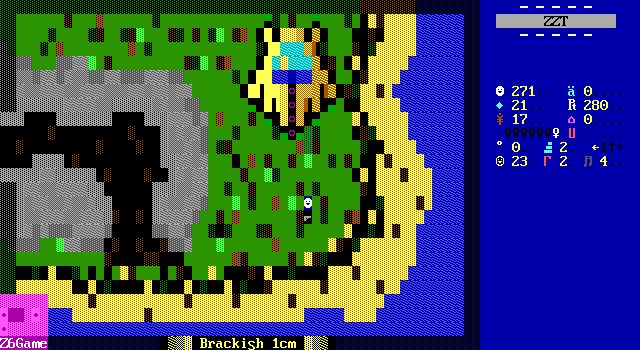
Most importantly though, the board with the gate on the other side of the cave holds more than just the gate itself, a casually discarded gun provides the player with the critically needed offensive power to do better than Pyrrhic victories against some of the more aggressive foes in Pepper Bolette. Ammunition remains a problem, though some objects in the cave will set your ammo count to a clip of 17 shots.
Dead Woods
While Pepper Bolette is generally quite open ended, a lack of equipment can make many areas fruitless to explore. The Dead Woods are perhaps the best example of this. At only two boards in length this is the smallest environment in the game that isn't just a cave to traverse. It happened to be the first place I ventured in my playthrough, but wound up being the last one I was able to complete as your objective here can't be completed without an item also found in the Dead Woods. Alas, said item can't be obtained either until you have the Truth Specs. (The game refuses to let you find the hidden item while it's invisible so no clever tricks here.)
Even with little to do on an initial excursion, the Dead Woods are what won me over on the game, and are the one part of the game I could remember from back when Pepper Bolette was a new release. The woods have this wonderful animation of falling leaves that really capture the level of quality put into the game's backgrounds. Forests are easily some of the most common outdoor areas in ZZT worlds, and you'll find plenty by various skilled artists throughout the worlds of ZZT.
It's safe to say that if you've played a good amount of ZZT games, you've seen countless takes on forests and trees of all kinds. So it's rather rare accomplishment to have a forest environment that can still impress and truly stand out.
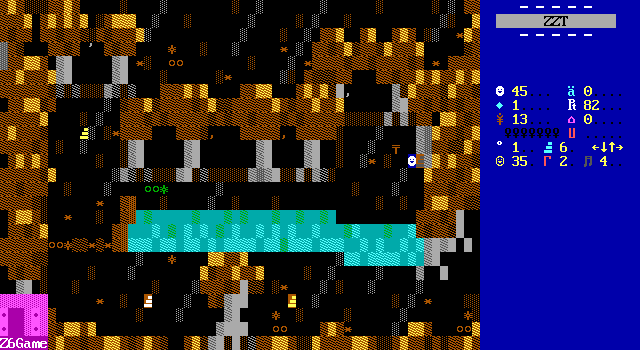
So when you enter the forest and this is what you're greeted with, it's perfectly reasonable to be so distracted by how brilliant the effect is that you don't notice an enemy approach. Sometimes you can't see the centipede for the trees.
And that centipede! Again like the tigers before, Zephyre is working entirely with objects and no built-ins. This time it's not to make a punchable centipede, but to make an indestructible one. No pistol, rifle, or smack will do anything to a Hyperpede. Yet they move just like the real deal. It's a simple system of the head making its movements and then passing instructions to its segments to get them to follow behind. Also it shoots at the player when aligned which can lead to jumping out of your seat if you let it get close before lining up and offering a nasty surprise.
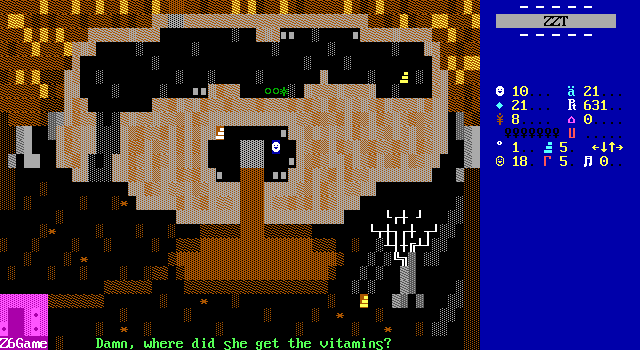
The Dead Woods weren't always dead, and your goal here is to actually bring them back to life. A mermaid (yes) outside the entrance is crying. One of the less friendly giant carnivorous plants had captured one of her friends and the only way to save her was to block the spring that supplied the forest with water. Her friend was saved, but now the forest is dying, which sucks not just for the whole local ecosystem, but also because the amount of harm she inflicted to the forest is enough to receive capital punishment.
Yllimpse's justice system isn't exactly explored. No idea what laws exist here or how the people living in the area handle these things. It's not important. The solution is to instead find a way to take remove the massive boulder that this buff as hell fish-lady must have suplexed into position.
The Dead Woods are also unique in that it was the only part of the game where I ran into a pretty severe bug. A passage error on the second board causes a passage to lead to the same board which unless I'm missing an alternate way of getting back (definitely possible, I wasn't using any special items to reveal secrets at the time) does actually a soft-lock. Unfortunately, while you can access the boulder and return from there no problem, you need to use the busted passage to the get to the part of the board that holds the hidden Power Arm item in order to be able to move the boulder. A simple zap or two is sufficient to get around it, but it's a surprising oversight for a Featured World of this vintage to have.
Fixing the boulder issue will result in the player acquiring one of the purple orbs necessary to return to consciousness. Strangely, not from the mermaid as a way of thanking you, but it's found buried beneath the boulder. A good deed is its own reward.
Rainy Woods
What appears to be just another cave entrance is actually a magical portal to the Rainy Woods. This region is where the bulk of the game takes place as these woods also connect directly to a third location as well. Combined, this area is sizable enough to be a game on its own with a lot of boards to explore and enemies to deal with. It's not merely a "level" or anything though. In addition to numerous action boards, you'll find numerous friendly NPCs scattered all around the area as well as a second village just to the south of the starting location.

As you'll come to expect from this game, the region begins with lots of unique animations that really bring the place to life with details rarely seen. The Rainy Woods have to live up to their name, and Zephyre makes it so with a gorgeous falling rain effect that again takes advantage of the background area being safe to put objects that would be a nuisance to the player were they interfering with where they wanted to move. The rain hearkens back to Mrs. Clause's own weird adventure game with a font, Village that has a similar effect, though it doesn't go so far as to show the raindrops splashing as they strike the ground.

This is also where the Myconians come into play. Without a translator device they only blow spores, with one, each will have a unique message or two. Most of it fairly basic stuff, the sort of thing you'd expect out of random villagers in a video game that exist mostly to keep the streets of a town from being empty. "You're in Bolette", "The Myconian in the village is helpful", "If we get hurt, it's your @$$", that sort of thing.
The threat at the end is another fun little idea Zephyre had. These mushroom-folk, reasonably, do not like being shot. As such, they all run a constant loop checking if they're blocked in any direction by something other than the player, and if so they will move in a random direction perpendicular to the threat. This leads to some really amusing last-second dodges if you're trying to shoot one (read: fuck around) to see what happens (read: find out).
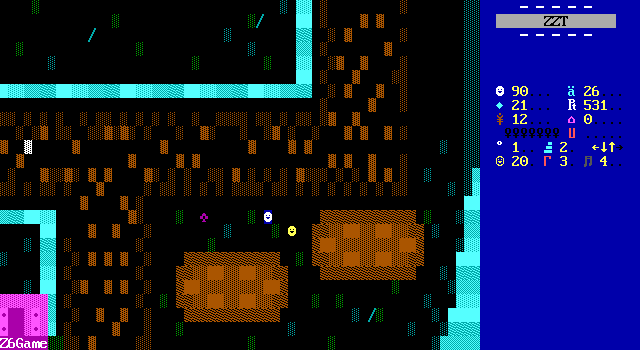
(Apologies for the random hitch in this GIF?)
Actually shooting one requires help from an enemy to block its movements or provide some bullets of their own. You pretty much have to get these things into a corner to see their wrath, which is actually just firing a few bullets in random directions and then acting like everything is normal. I was honestly surprised at how tame they were given how difficult they are to hit, but you know what, maybe I shouldn't be shooting things in the name of science.
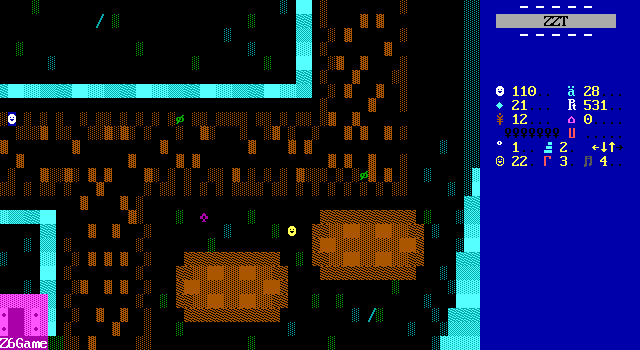
The differences between the original release Pepper Bolette and the game being played, Pepper Bolette Special Edition are pretty minor. Graphics are tweaked a little, the linking board looks a bit nicer, and some more devastating bugs are fixed. It feels more like a version 1.1 than a major revamp that's usually associated with "Special Edition" in the context of ZZT worlds. Given the barely four months between each version and the filename of this release being "BOLETTE(FIX-A-DENT).zip"
This board also defies the established convention by having some raindrops in an area the player can reach. If you head into the corner you'll get shoved around a bit, but I don't think this is a flaw. This board and the connecting boards are designed in such a way to discourage walking to those regions. All this does is keeps the paths a little bit wider than they'd otherwise be, something useful for quick navigation in the event you do wind up in a corner so you can deal with enemies. I really feel the design choice here to be willing to add these effects knowing that the odds are they will never hinder the player is worth the small trade-off of how minor that hindrance ultimately is.

Of all the changes between the original and Special Edition, one of the few that's readily apparent from just looking at boards is the addition of a hunter named Roland. They offer 10 health for 10 gems as a pricey source of healing, but more importantly Roland also carries a book containing information on all the creatures of Bolette along with some tips on how best to deal with them. I'd like to discuss the enemy design of Pepper Bolette in its own section, as there's quite a lot of it, but for now known that having access this handy little guide helps provide context to these creatures who otherwise tend to go nameless within the gameplay.
The text itself is an external document brought up within ZZT meaning there's no fight for memory between the board and the book so Zephyre can get a little wordy with these. It's also written very much in universe which sells the idea that this is an artifact of the world itself and not a clinical manual for the game added for the second release.
Seaweed Isle
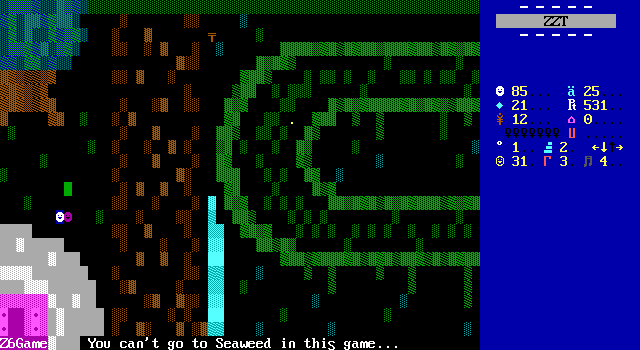
Pepper Bolette is very clearly a world greater than what fits inside of a ZZT file. By ZZT standards it's a reasonably lengthy adventure that doesn't outstay its welcome. Still there's no better sign that the game as released is not Zephyre's full vision than the abrupt edge of the woods with a sign for an area that had to be scrapped entirely. The file clocks in a good 330+ kilobytes, definitely hitting the upper limit of what was considered an informal maximum for individuals files.
It's a good sign when the sign that reveals some significant scrapped plans elicits a reaction of disappointment and not relief. The visual tricks throughout Pepper Bolette alone are enough that I would have liked to see what else may have been planned for this region.
Foggy Forest
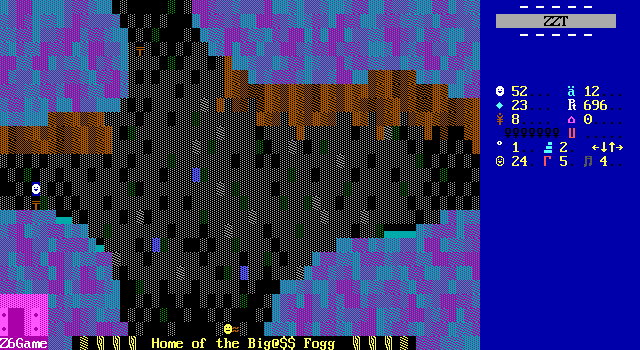
Undoubtedly, it's the Foggy Forest region of the game that I found the most atmospheric. This is despite the fact that the area really doesn't have any fancy effects like the raindrops or falling leaves. Impressive ZZT art shows up yet again with the environment certainly feeling foggy through the use of gray fakes everywhere and some particularly dreary looking colors for the trees.
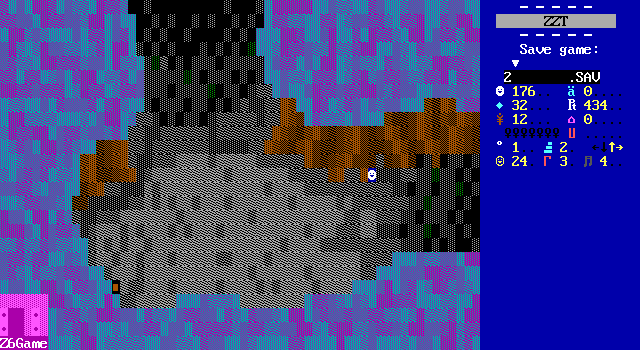
"Art direction" is not a phrase that can often apply to ZZT, but it's certainly suitable here. The obvious sign that thought was put into this environment is the font. The replaced water character (normally ) gets to strut its stuff here. Now significantly more filled in than its predecessor the Foggy Forest is much more capable of being thick with fog in the foreground. Several boards have these thick pockets that need to be navigated carefully. They're effectively tiny mazes and it should be no surprise to anybody that's seen any of my livestreams of lower quality ZZT worlds how much I despite them. Zephyre makes them work nicely with the fog as a method of justification. (Plus items can be equipped to instantly reveal the paths if you have them.)
Second, is that the fog is worked so well into the gameplay. At first, it's very easy to walk into the Foggy Forest from the Rainy Woods and think it's the same area with different paint. The forest differentiates itself once you realize how dangerous it is.

Much of the forest features these scattered bits of dense fog. They're positioned in a way that the player almost certainly has to move next to them, and that's when their contents are revealed. Sometimes hidden inside will be a nice shiny gem. More often than not, it will be an enemy waiting to ambush the player. This design works remarkably well thanks to the amount of back and forth throughout this game. You'll have the option of taking it slow, trying to avoid any surprises, but really want to just hurry up and cross the board, likely getting attacked in the process for rushing.
You can mitigate this by shooting the fog as well, but with how limited ammo is for much of the game, unless you're ready to promptly reload if there isn't a foe hiding in the mist you'll be going through quite a lot of shots for little benefit. Were the fog just a nuisance to hide enemies in, it could get frustrating. Zephyre also hiding gems inside while not much, is just the slightest nudge to get you to press your luck.
Molten Degree
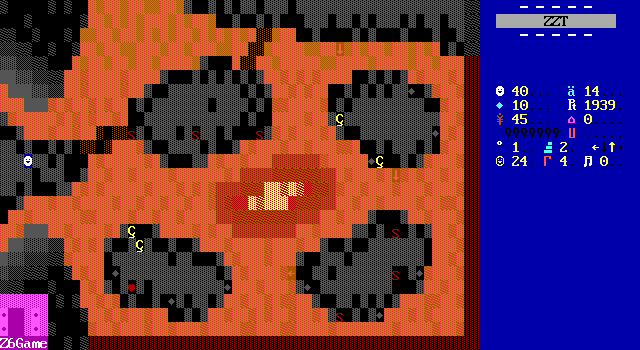
The last region of the game (in the order I found them all) is Molten Degree, an underground cavern filled with pools of animated magma. This looks to be extensively using yenrab's old 1 Object Fire technique which when nearly filling multiple boards ends up being the most animated effect of all.
Molten Degree can't be safely explored until the player has found the Rock Ice item. Without it your health slowly drains turning the trek to much more linearly arranged region into a death sentence.
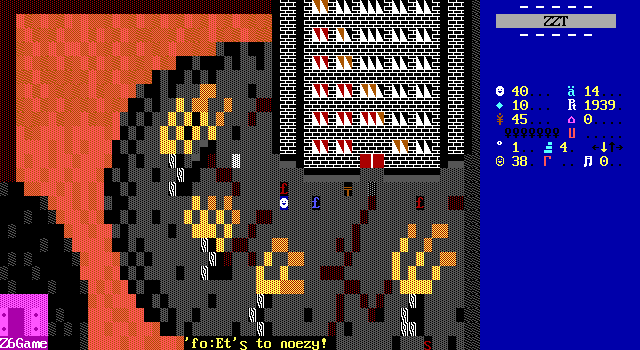
Plenty of others can handle the heat with the region being host to a popular club located within Hell Hotel as seen here. The bricks and windows make from triangles in combination with the fire effects really give this part of the game some heavy early MegaZeux vibes. This screams Caves of Zeux to me.
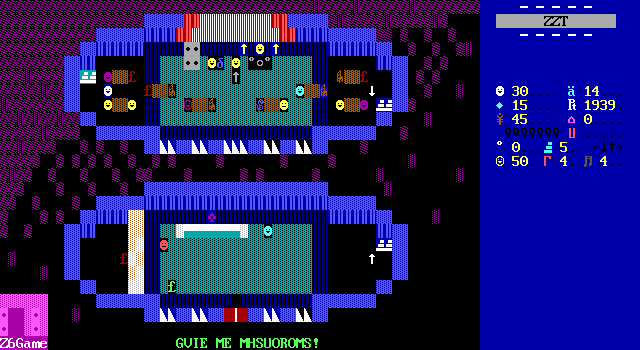
The hotel is a pretty big departure from the design of the rest of the game. The second floor has a live band that's responsible for most of the crowd. I love their instruments, and the giant speakers made even better by three of the four looping an animation to convey that they're blasting out sound. Then there's that poor fourth one that must be blown.
The entire segment is a weird change of pace with the player no longer fighting weird animals, and instead helping folks out with some mundane tasks. You get to become a de facto waiter that brings people their requested food and drink, plus recover some dropped items by a hotel guest who can't stand the band's music and doesn't want to go down there himself. It really shifts the tone in an unexpected way, with the whole segment over before you know it. I'd compare it to Run-On's transformation to procedurally generated action-runner to a sudden stay at a bar in the Passive Semantic chapter.

